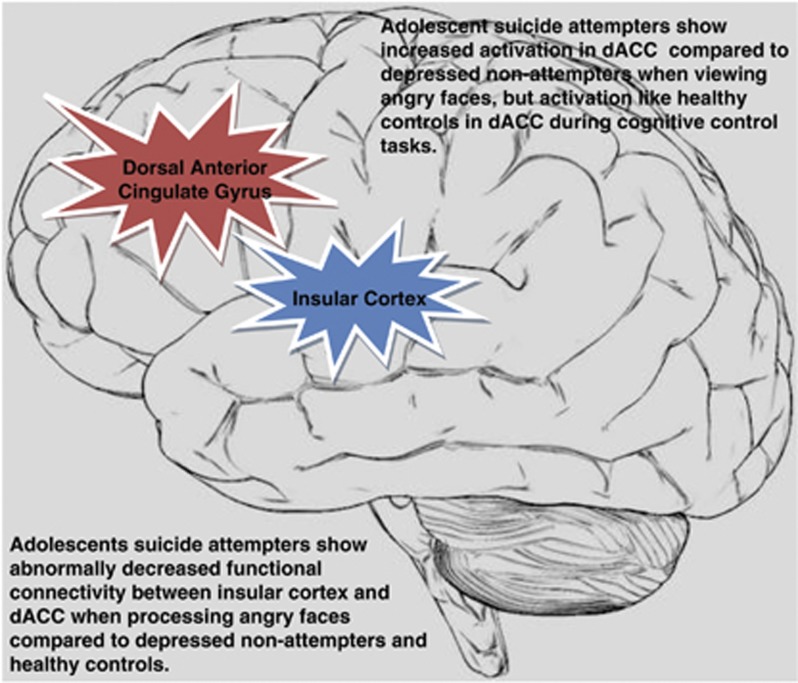Suicide remains a leading cause of adolescent morbidity and mortality. Despite identification of risk factors and protective factors for suicidal behavior, we have limited understanding of the mechanisms underlying risk for suicide attempt. Adolescence is a time of high risk for suicidal behavior, as well as a time that intervention and treatment may have the greatest impact because of structural brain changes and significant psychosocial development during this period. Functional magnetic resonance imaging (fMRI) studies have promise to yield markers of risk for suicidal behavior in adolescents because they can help identify neurobiological underpinnings of pathophysiologic mechanisms that are not observable at the behavioral level, and can also provide targets for future neurobiological interventions. Markers of risk for suicidal behavior are beginning to be elucidated, but as yet have not been applied to the clinical management of adolescents at risk for suicide.
Neuroimaging studies indicate neural circuitry abnormalities in adult suicide attempters. One study in adult suicide attempters reported lower glucose uptake in the prefrontal cortex and dorsal anterior cingulate gyrus in high vs low lethality suicide attempters (Oquendo et al, 2003). With regard to emotion processing, vulnerability to suicidal behavior has been associated with differences in response to negative emotion. Specifically, adult male suicide attempters showed greater activity in the right lateral orbitofrontal cortex and decreased activity in the right superior frontal gyrus to intense angry vs neutral faces relative to healthy and depressed non-attempter controls. In addition, cognitive inflexibility (inability to change strategy) is well documented in studies of adult patients with a history of suicide attempt (Jollant et al, 2005). However, few studies have explored the neural circuitry underlying adolescent suicidal behavior. This is an important oversight because suicide is one of the leading causes of death in adolescence, and the developing brain may provide a window into risk for suicidal behavior and allow for earlier intervention to prevent suicide.
Our functional neuroimaging studies indicate differences in emotion processing in adolescents with history of depression and suicide attempt relative to healthy control adolescents. Here, we have shown differences in the attention and salience networks (Pan et al, 2013). Our findings differ from those in adult males with depression, in whom the functional connectivity of the striatal-anterior cortical midline structures circuit is implicated in suicidal ideation (Marchand et al, 2012). Specifically, we have shown increased attentional control network activity and decreased functional connectivity between the dorsal anterior cingulate gyrus, implicated in attentional control of emotion, and the insula, a neural region associated with interoceptive processing of emotion, when viewing angry faces in adolescents with a history of depression and suicide attempt compared with healthy controls and depressed adolescent non-attempters (Figure 1). In contrast, adolescents with a history of depression and suicide attempt showed no abnormalities in levels of performance accuracy or dorsal anterior cingulate activity and attentional control network activity on tasks of cognitive control and learning in the context of risk (Pan et al, 2011, 2013). Together, these findings suggest that abnormal functioning of the salience and attention networks in the setting of emotion processing, with normal function in these networks in the absence of emotional stimuli, may represent markers of past suicide attempt. These networks are thus promising foci for future neuroimaging studies aiming to identify markers of risk for future suicide attempt in adolescent populations.
Figure 1.
Summary of described functional neuroimaging abnormalities in adolescents with a history of suicide attempt.
FUNDING AND DISCLOSURE
The authors declare no conflict of interest.
Acknowledgments
This research was supported by the American Foundation for Suicide Prevention, the Klingenstein Third Generation Foundation Fellowship for Adolescent Depression, NIMH/National Institute of Child Health (NICHD) 1K23MH082884-01 to LAP, and NIMH MH076971 (to MLP).
References
- Jollant F, Bellivier F, Leboyer M, Astruc B, Torres S, Verdier R, et al. Impaired decision making in suicide attempters. Am J Psychiatry. 2005;162:304–310. doi: 10.1176/appi.ajp.162.2.304. [DOI] [PubMed] [Google Scholar]
- Marchand WR, Lee JN, Johnson S, Thatcher J, Gale P, Wood N, et al. Striatal and cortical midline circuits in major depression: implications for suicide and aymptom expression. Prog Neuropsychopharmacol Biol Psychiatry. 2012;36:290–299. doi: 10.1016/j.pnpbp.2011.10.016. [DOI] [PubMed] [Google Scholar]
- Oquendo MA, Placidi G, Malone KM, Campbell C, Keilp J, Brodsky B, et al. Positron emission tomography of regional brain metabolic responses to a serotonergic challenge and lethality of suicide attempts in major depression. Arch Gen Psychiatry. 2003;60:14–22. doi: 10.1001/archpsyc.60.1.14. [DOI] [PubMed] [Google Scholar]
- Pan L, Segreti A, Almeida J, Jollant F, Lawrence N, Brent D, et al. Preserved hippocampal function during learning in the context of risk in adolescent suicide attempt. Psych Res. 2013;211:112–118. doi: 10.1016/j.pscychresns.2012.07.008. [DOI] [PMC free article] [PubMed] [Google Scholar]
- Pan LA, Batezati-Alves SC, Almeida JR, Segreti A, Akkal D, Hassel S, et al. Dissociable patterns of neural activity during response inhibition in depressed adolescents with and without suicidal behavior. J Am Acad Child Adolesc Psychiatry. 2011;50:602–611. doi: 10.1016/j.jaac.2011.03.018. [DOI] [PMC free article] [PubMed] [Google Scholar]
- Pan LA, Hassel S, Segreti AM, Nau SA, Brent DA, Phillips ML. Differential patterns of activity and functional connectivity in emotion processing neural circuitry to angry and happy faces in adolescents with and without suicide attempt. Psychol Med. 2013;9:1–14. doi: 10.1017/S0033291712002966. [DOI] [PubMed] [Google Scholar]



